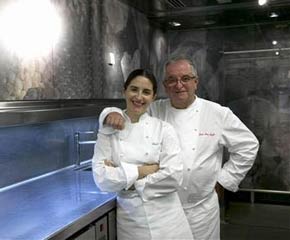Foodies flock to for a taste of modern Basque cuisine at their restaurant called Arzak. Ranked among the best in the world, for foods such as oysters wrapped in cellophane, fiber-optic potatoes, champagne ravioli and bubbling pineapple.
Let’s find out more about what inspires them to create their distinctive style of cooking.
Q: You once prepared a meal for Queen Elizabeth. Who do you most like to cook for?
JM: “In this community, there is no class distinction. This is a restaurant of three Michelin stars but it is a restaurant where all types of people come. Those of upper class could come once a month and those of middle or lower class will still come, but maybe only once a year.”
Q: Can you describe what investigative cuisine means?
JM: “The cuisine is of Basque roots, not of traditional Basque roots. We distinguish between traditional Basque cuisine and cuisine with Basque roots. Roots is the way of being of a people, a genetic heritage, a cultural heritage, a heritage of taste that we carry in our blood … The cuisine of Basque roots is cuisine of investigation, it’s a cuisine of evolution, ours in Arzak, it’s a cuisine in the vanguard.”
Q: Can you describe a typical dish from the restaurant that exemplifies that philosophy?
E: “Hake with white clay: It’s a favourite local fish and we serve it with a white clay, that you can eat, that is with no sand.”
JM: “The idea came to us because we were working with the land to make a sauce from the earth. After we started to do a type of compost of different types of earth, we collected the earth from parts where there is no deteriorating substances like that of the forest, and then we cooked this and what we ended up with was an extract that tastes of minerals and of truffles, and depending on what forest we take the earth from, the leaves that have fallen to the ground could be of cherries, could be of apples, and it gives the flavour a special touch.”
Q: How do you stay inspired?
JM: “You always have to have the capacity to be surprised. And ideally, to have the capacity to be surprised, you need to think like a child. If you think like a child your imagination will never run out.”
E: “Inspiration comes from many different ways, from what you see every day. Perhaps if I go to the street, I go to an ice-cream shop and I see granita of horchata (a beverage made from tigernuts, water and sugar), so I can come to the restaurant and say I’m going to make a dessert with horchata.”
Q: What is your favourite thing to eat?
JM: “I like caviar, I like foie gras, I like white truffles, but for me, what I like best to eat, for my taste, is a couple of fried eggs with a few piquillo peppers on the side.”
E: “I like truffles a lot, I like cheese, but especially a local cheese called idiazabal.”

